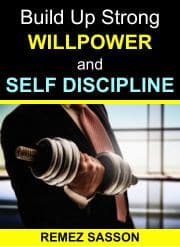
If you have a clear direction in life, and feel ready to move forward, self doubt can be the fastest way to slow you down.
If you believe the inner voice of doubt, it can easily rob you of your enthusiasm, bring up fear, and negate all the preparation you’ve done toward achieving your goal.
So, at some point along your path, it becomes necessary to turn self doubt into confidence.
Browse our online courses on meditation, positive thinking, overcoming procrastination, confidence, and freedom from distractions.
Confidence is not arrogance, bluster, or posing. It’s grounded quiet assurance.
Confidence and Lack Self Confidence
Usually those with natural self-confidence had the good fortune to have grown up in an environment where trying new things was encouraged, and making mistakes was simply considered a normal part of learning, not a sign of failure.
Those who lack self confidence usually didn’t have the opportunity early on to receive encouragement, make mistakes, and be encouraged to try again.
Self doubt and fear go hand in hand, and together undercut confidence. When we fear we’ll be punished for our mistakes, self doubt comes in to keep us from taking a risk so we won’t get into that position.
We subconsciously learn the pattern of self doubt as a kind of protection against failure. Together, fear and self doubt keep us immobile and unfulfilled, and that’s the opposite of what we’re after.
When we’re new at something, it’s important to try it under safe conditions, ideally with others who are also new, with the idea that it’s OK if you don’t get it right immediately. It’s called training.
For example, if we’ve never skied before, we wouldn’t be well advised to go straight down the highest mountain. We’d take lessons on the bunny hill until we gain experience and confidence. Then, when we’ve mastered that stage, we’d move on to something more difficult.
Training is an important step to gain confidence. But to carry self doubt beyond the training stage is to let an unconscious pattern from the past keep us from moving forward, in service to fear of failure.
You Need tot have Self Confidence
Self doubt often arises when we’re faced with a situation in which the best direction to take is uncertain, perhaps because there’s not enough information to know for sure what to do.
Those with self confidence don’t dwell on decisions under those circumstances. They either pick the most likely direction and move forward, or stop and gather more information until it’s clear.
Either way, they continue to learn and make progress. But for those with self doubt, uncertainty can lead to paralysis, because it triggers old fears that we’re about to make a mistake and be punished.
Those for whom self doubt is an issue need to spend time in a culture of acceptance, in which making mistakes is considered a normal and accepted part of making progress. The need to receive the opportunity to experiment, learn, and grow without fear of ridicule or punishment.
As we experience success under those circumstances, we’re able to release past programming, and learn we don’t need to be afraid of trying new things. Without the fear, there’s no need for self doubt, and it can drop away.
A culture of acceptance can be gained in an educational setting, under the supervision of a caring therapist, or even in the theater of the mind, using guided imagery or hypnosis.
All of these approaches can help us “get off the ground” and allow our dreams to take flight. Once we’re in motion, the best way to gain true confidence is by doing and succeeding, again and again, over time.
About the Author
Max Highstein is an intuitive guide, author, and teacher who’s work includes Transform Self-Doubt into Confidence. Learn more about his published work at TheHealingWaterfall.com.

